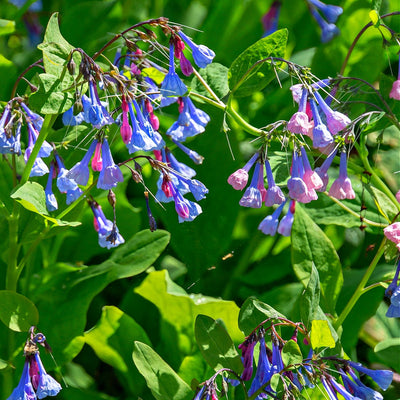Virginia Bluebells
With its light blue and purple hues, Virginia Bluebells add elegance to any garden and outdoor Sustainable Landscape. This favorite flower begins as a small pink bulb and develops into a flower capable of growing to heights between 18 and 24 inches.
Facts About Virginia Bluebell Plants
These delicate plants are best suited for shaded areas. You can find the Virginia Bluebell plant in abundance in the woodlands of eastern and midwestern parts of the United States. Perennial plants live for years.
Virginia Bluebell plants bloom quickly during the spring season. When paired with other shade-loving plants, they grow exceedingly well. Plants that you can pair with Virginia Bluebell flowers include ginger and hostas.
How to Grow Your Virginia Bluebell Flowers
The best part about selecting Virginia Bluebells is they do not require you to be knowledgeable about growing flowers correctly. Another excellent characteristic of this herb is it does not attract insects.
With these characteristics, it is relatively easy to grow Virginia Bluebell plants. To have a successful experience growing these plants, you should follow these steps.
1. Determine whether you have the right soil conditions to grow the plant. The soil must be rich and moist (not wet). Virginia Bluebell plants do not fare well in moist soil. Test the pH of the soil to verify that it is as close to 7.0 as possible.
2. Plant and cover the seeds. Keep in mind that the germination period for these seeds is between one and two months.
3. If you have purchased Virginia Bell plants from a nursery, plant them in the autumn or spring. These plants should be spaced 8 to 12 inches apart.
How to Care for Virginia Bluebells
As stated earlier, you do not have to have a 'green thumb' to experience these flowers successfully. However, there are a few things that you must do to maximize this flower's chance of reaching its potential. The roots must be kept cold. You can accomplish this through mulching; Inorganic and organic mulch will do the trick. Types of natural mulch include wood, bark, compost, grass clippings, and leaves. Inorganic types of mulch include rocks, plastic sheeting, and rubber chips. It is best to consult a gardening professional to determine the type of mulch best suited for Virginia Bluebell plants.
Be sure to follow the proper watering guidelines for this plant. Watering your Virginia Bluebell plants should be done with care. Water the seeds and plant regularly. As soon as you notice the flowers are blooming, water them occasionally. When the growing season has ended, it is unnecessary to water these plants. What Makes Virginia Bluebells Stand Out? Virginia Bluebell plants can make a hassle-free addition to your garden. With proper care and maintenance, these plants can thrive.

